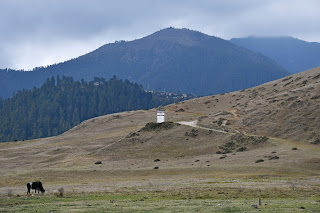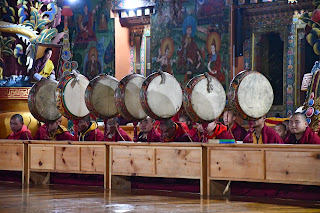Bhutan – Day 7: Phobjikha Valley
Today’s programme was more leisurely than our previous experiences. We departed from our hotel in Phobjikha after nine o’clock to visit Gangtey Lhakhang, a monastery built by Peling Gyaltse Rinpoche, grandson of the terton Pema Lingpa. It is said that Pema Lingpa himself predicted the construction of a temple in the Valley of Phobjikha, which is known for being the winter home of black-necked cranes. These are said to circle the temple three times before landing in the valley.
Leaving Gangtey Geonpa
on foot, we slowly passed through the village of Nubding, stopping by a few
souvenir shops and convenience stores. We also ate some warm snacks at a local
restaurant: while others munched on some kind of Bhutanese sausage, I had a
fried chili pepper. Continuing on our walk, we passed through several villages
separated by forests and fields. Our destination was the lookout over Phobjikha
Valley, an old glacial formation now dominated by a small stream with many
twists and turns. Because it is very marshy, the valley is a favourite with
black-necked cranes, as the barren and treacherous landscape thwarts predators.
We descended from the
lookout point until we found ourselves walking through one more village to
reach Khewang Lhakhang, another temple with an interesting background. This one
is said to have been built on the site where a young man was killed by a
demoness disguised as his beloved. When his body fell to the ground, it made a
hole into a rock which can be seen to this day.
When a tour group
approaches a little-visited temple, the local guide usually searches for a monk
with keys to the inner sanctum. This time, however, we were spotted by a group
of young boys digging into a mound with comically oversized shovels. They shouted
hellos at us and one of them kicked a football in our direction, which was
masterfully received by one of my fellow travellers. Satisfied, the boy opened
the door into the temple and led us through it, pouring holy water into our
hands and pointing at various objects saying things we could not understand.
We then drove along
the rocky road that leads across the bottom of the valley, passing by marshes
on both sides and crossing over a few winding streams. We stopped to take
pictures of a herd of yaks, but they timidly ran away from the side of the
road. When we reached the other side, we ate lunch and visited the Black-Necked
Crane Centre. Although the birds only visit Phobjikha Valley in the winter
months, the centre takes care of those which – being wounded or sick – are
unable to leave. There were two cranes, a male and a female, at the time of our
visit.
The highlight of the
day, however, was our visit to Kuenzang Chholing Shedra, which serves as the
school and university to Gangtey Lhakhang. We were scheduled for a short
question and answer session, but only three of us ended up going and joined
another equally small group of Indian tourists. We began with general questions
on Buddhism in Bhutan. However, we slowly yielded to an elderly man from the
other group: he seemed to be on a desperate spiritual quest to find the route
to happiness and discover the meaning of life.
A man in his
mid-thirties, the lama emanated a self-assured serenity. He had a monk serving
as translator to his left but clearly understood our questions, laughing
thoughtfully and rubbing his bald head with both hands before the translator could
relay them in their entirety. He likened life to a precious boat traversing a
sea of suffering, and he explained happiness as being found in the happiness of
others. The latter was a very Mahayanistic response, emphasising the collective
escape from samsara over individual salvation. Following the same thread, we
finished with a short compassionate meditation exercise. As we breathed in, we
were supposed to think of all the suffering in the world, and upon breathing
out, we were supposed to imagine those suffering as receiving peace.
With the end of our
conversation drawing near, we were invited to observe evening prayers at the
temple. It was the most impressive religious ceremony we have seen so far. The
sanctum counted over a hundred young monks facing each other across the aisle while
rhythmically reciting their prayers. After some time spent in unaccompanied recitation,
the monks sitting closest to the centre began to beat their drums and cymbals,
and a smaller number blew their thunderous droning horns. Then the music died
down again, and the whole ebb and flow began anew.
For dinner, we visited
a local family in Phobjikha Valley. It was a colourful experience. Before we
could sit down on the rugs arranged around the metal stove, the cat threw up on
one of them, prompting the hostess to quickly sweep the bulk of it and place
another rug over the rest. Our guide told us that the chimney leading from the
stove had only been installed relatively recently; traditional houses tend to
have a chimney-less stove or fireplace in the middle of the living room, and the
only way people can ventilate is by opening the door.
The food was a bit
rough, but of course the multiple courses brought before us indicated we were
being treated as honoured guests. This night was my first time trying salty
butter tea and orchid soup, and though they probably won’t become my
favourites, I am glad I had the chance to try them. Nevertheless, the most
surprising part of the experience was visiting the family shrine. It was by far
the tidiest and most lavish room in the house, filled with countless banners
and statues. On the seat of honour sat a framed photograph of the hostess’s
son, who was recognised as a reincarnation of an important lama and is now
studying at a prestigious monastic school.







































Comments
Post a Comment